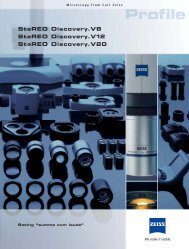optical interference filters - SPOT Imaging Solutions
optical interference filters - SPOT Imaging Solutions
optical interference filters - SPOT Imaging Solutions
You also want an ePaper? Increase the reach of your titles
YUMPU automatically turns print PDFs into web optimized ePapers that Google loves.
Astronomy <strong>filters</strong><br />
Throughout our history, we have designed and manufactured custom <strong>filters</strong> and standard prescription <strong>filters</strong> to the highest<br />
imaging quality standards for astronomers, atmospheric scientists, and aerospace instrumentation companies worldwide. Applications<br />
include both terrestrial and space-based observational instruments. We are the supplier of choice for a wide variety<br />
of prestigious universities, observatories, government agencies, and international consortia. As instrument technologies and<br />
applications evolve, we work collaboratively with our customers to develop solutions for the spectral, <strong>optical</strong>, and environmental<br />
demands that will define observational astronomy and aerospace applications in the future.<br />
Hubble Space Telescope (HST)<br />
We have played a key role as the supplier of <strong>interference</strong> <strong>filters</strong> throughout the existence of the Wide Field Planetary Camera 2 and 3 (WFPC2,<br />
WFPC3), in service from 1993 – to date. Our contribution of broad-band and medium band <strong>filters</strong>, covering the ultraviolet to near infrared<br />
spectrum, helped extend the world’s view to the furthest reaches of space through observations of the Hubble Deep and Ultra-Deep Fields.<br />
Closer to home, the now iconic “Pillars of Creation” in the Eagle Nebula, demonstrating star birth in stellar nurseries, was a major achievement<br />
in astronomical imaging. We are pleased to have been instrumental in the investigation of countless phenomena from galactic super clusters<br />
to intricate nebulas and the first direct observation of an extra-solar planet. As a supplier of <strong>filters</strong> for the next generation WFPC3 we are proud<br />
to continue our support as NASA extends its reach to the edge of the visible universe.<br />
Mars Rovers<br />
Our <strong>filters</strong> continue to explore the Martian landscape on the recently launched Curiosity as well as both the Spirit and Opportunity Rovers.<br />
The original launch of Spirit and Opportunity utilized a total of 3 sensor systems sending images of Mars in unprecedented clarity. Since 2004<br />
the "Pancam" has delivered high resolution multispectral images using a total of 16 <strong>filters</strong> divided between two detectors. Among the many<br />
mineralogical discoveries, our <strong>filters</strong> helped prove that water was present on the surface of Mars, furthering the consideration that life may<br />
have once existed on the red planet.<br />
Custom Filters & Sets<br />
Our ability to customize <strong>filters</strong> for imaging systems sets us apart<br />
from other filter companies. With over 25 deposition chambers in<br />
service employing a range of coating technologies from reactive<br />
sputtering and ion-assisted refractory oxide to physical vapor deposition,<br />
we have the most important capacity for a filter supplier,<br />
design flexibility. Below are general guidelines of our capabilities:<br />
Wavelength Range: 185nm – 2500nm<br />
Bandwidths: minimum 0.15nm to several hundred nm<br />
Design Considerations: Critical throughput,<br />
band-shape and bandwidth requirements<br />
Size: 2mm – 210mm<br />
Sets: Matching physical and <strong>optical</strong><br />
performance attributes<br />
Materials: Space-flight compatible<br />
High Spectral Performance<br />
We achieve maximum throughput while adhering to critical bandshape<br />
tolerances from the UV to NIR. Placement of cut-on/cut-off<br />
edges are carefully controlled and <strong>optical</strong> densities in excess of<br />
OD6 ensure that adjacent spectral regions do not impart noise on<br />
one another through crosstalk.<br />
Optical Performance<br />
As critical to the spectral performance of our <strong>filters</strong> is the preparation<br />
and care taken in the choice of substrates. Each filter is polished<br />
to guarantee optimum image quality.<br />
Large format <strong>filters</strong><br />
The use of CCD and other large format<br />
imaging detectors has revolutionized<br />
the study of astronomy. As both the<br />
size and sensitivity of these sensors<br />
have increased, Omega has<br />
pushed the envelope of coating<br />
technology to meet the<br />
need for large format <strong>filters</strong><br />
up to 210mm. Our designs<br />
achieve the highest<br />
level of uniformity while<br />
maintaining the critical<br />
surface quality and<br />
transmitted wave-front<br />
requirements so critical<br />
to precision imaging.<br />
Martian surface.<br />
Photo courtesy of NASA/JPL/Cornell<br />
For current product listings, specifications, and pricing:<br />
www.omega<strong>filters</strong>.com • sales@omega<strong>filters</strong>.com<br />
1.866.488.1064 (toll free within USA only) • +1.802.254.2690 (outside USA)<br />
45

















